Panasonic NN-CS596SBPQ User Manual
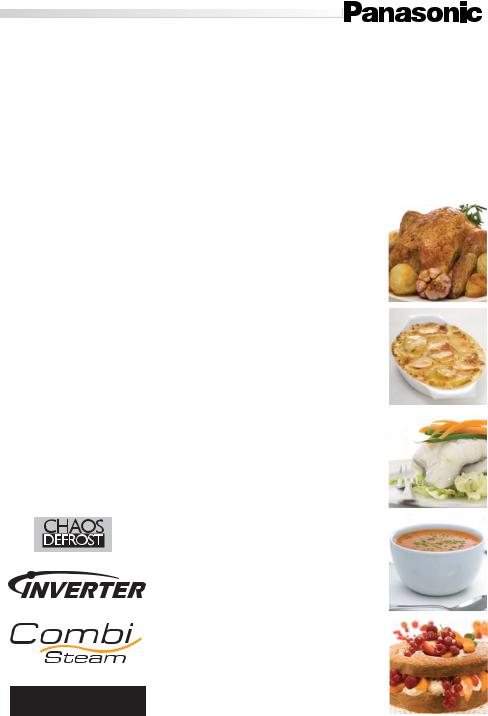
®
Convection Combi Steam Oven
Operating Instructions and Cookbook
NN-CS596S

Welcome to Panasonic Microwave Cooking
Thank you for purchasing a Panasonic Microwave Oven.
Even if this is not your first microwave oven, do please read the opening chapters of this cookbook to achieve perfect results every time.
This microwave oven has the benefit of the Inverter System Inside. This unique technology has been in use with microwave ovens in Japan for many years, improving the cooking performance of the oven. It also means that you benefit from having more space inside your oven, without taking up more room on your work surface. Panasonic has introduced the UK’s first cooking appliance providing complete versatility with four cooking technologies in one single oven including combi steam technology.
We hope you enjoy using your new oven but should you require any further help or explanation, phone our COOKERY ADVICE LINE 01344 862108
or write to the address below.
The Microwave Test & Development Kitchen Panasonic Consumer Electronics U.K. Willoughby Road
Bracknell Berks RG12 8FP
Or e-mail test.kitchen@panasonic.co.uk
When writing, be sure to state your model number and daytime telephone number.
CONTENTS |
|
• Combination Cooking |
41-52 |
Safety Information |
2 |
Auto Weight Programs |
53-59 |
Caution |
3 |
Cooking and Reheating |
|
Unpacking your oven |
3 |
Guidelines |
60 |
Placement of your Oven |
3 |
Reheating Charts |
62-64 |
Before using your Oven |
4 |
Cooking Charts |
65-78 |
Care and Cleaning |
5 |
Adapting Recipes |
79 |
Maintenance of your Oven |
6 |
RECIPES |
|
Parts of your Oven |
7-8 |
|
|
Important Information |
9-11 |
Soups and Starters |
79-88 |
Microwaving Principles |
12-13 |
Fish |
89-101 |
General Guidelines |
14-16 |
Meat and Poultry |
102-133 |
Containers to use |
17-19 |
Vegetables/Vegetarian |
135-156 |
Control Panel |
20 |
Pasta, Rice & Beans |
157-164 |
Operating Instructions |
21-59 |
Cheese and Egg Dishes |
165-173 |
• Demonstration Mode |
21 |
Sauces and Preserves |
175-191 |
• Child Lock |
21 |
Pastry |
192-203 |
• Setting the Clock |
22 |
Desserts and Baking |
205-239 |
• Microwaving/defrosting |
22-29 |
Bread |
239-247 |
• Steam and Microwave |
30-31 |
Index |
248-250 |
• Using the Delay/Stand Feature |
32 |
Questions and Answers |
251 |
• Grilling |
33-34 |
Technical Specification |
252 |
• Convection cooking |
35-38 |
|
|
• TURBO-BAKE cooking |
39-40 |
|
|
1
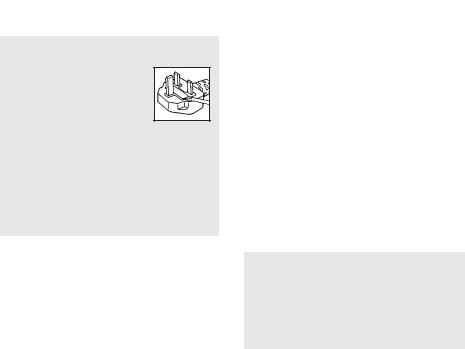
Important safety instructions
Please read carefully and keep for future reference.
This appliance is supplied with a moulded three pin mains plug for your safety and convenience. A 13 amp fuse is fitted in this plug. Should the fuse need to be replaced, please ensure that the replacement fuse has a rating of 13 amps and that it is approved by ASTA or BSI to BS1362. Check for the ASTA mark or the BSI mark on the body of the fuse.
on the body of the fuse.
If the fuse cover is detachable, never use the plug with the cover
omitted. If a replacement fuse cover is required, ensure it is the same colour as that visible on the pin face of the plug.
A replacement fuse cover can be purchased from your local Panasonic Dealer.
HOW TO REPLACE THE FUSE
Open the fuse compartment with a screwdriver and replace the fuse.
IF THE FITTED MOULDED PLUG IS UNSUITABLE FOR THE SOCKET OUTLET IN YOUR HOME, THEN THE FUSE SHOULD BE REMOVED AND THE PLUG CUT OFF AND DISPOSED OF SAFELY AND AN APPROPRIATE ONE FITTED. THERE IS A DANGER OF SEVERE ELECTRICAL SHOCK IF THE CUT OFF PLUG IS INSERTED INTO ANY 13 AMP SOCKET.
If a new plug is to be fitted, please observe the wiring code as shown opposite. If in any doubt, please consult a qualified electrician (For U.K. Models only).
WARNING: THIS APPLIANCE MUST BE EARTHED.
IMPORTANT: The wires in this mains lead are coloured in accordance with the following code: Green-and-yellow: Earth, Blue: Neutral, Brown: Live.
As the colours of the wire in the mains lead of this appliance may not correspond with the coloured markings identifying the terminals in your plug, proceed as follows:
The wire which is coloured GREEN-AND- YELLOW must be connected to the terminal in the plug which is marked with the letter E or by the Earth symbol  or coloured GREEN or
or coloured GREEN or
GREEN-AND-YELLOW.
The wire which is coloured BLUE must be connected to the terminal in the plug which is marked with the letter N or coloured BLACK.
The wire which is coloured BROWN must be connected to the terminal in the plug which is marked with the letter L or coloured RED.
When this oven is installed it should be easy to isolate the appliance from the electricity supply by pulling out the plug or operating a circuit breaker.
Voltage & Power
The voltage used must be the same as specified on this microwave oven. Using a higher voltage than that which is specified is dangerous and may result in a fire or other type of accident causing damage.
Do not immerse cord, plug or oven in water. Keep cord away from heated surfaces. Do not let cord hang over the edge of table or work top. Do not plug your oven in via an extension cable as this can be dangerous. It is important to plug the oven directly into a wall socket.
The back of the appliance heats up during use. Do not allow the cord to be in contact with the back of the appliance or cabinet surface.
2
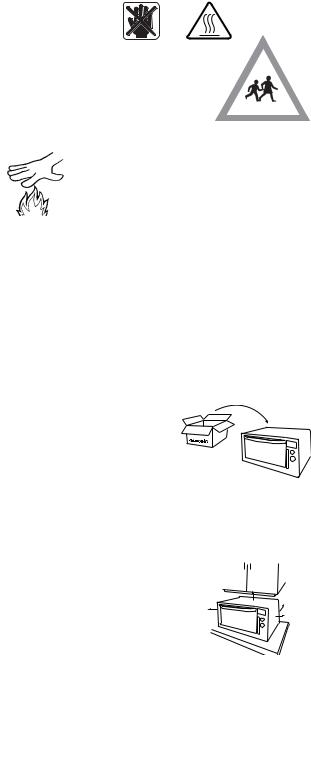
Caution: Hot surfaces
1. Hot Surfaces
Exterior oven surfaces, including air vents on the cabinet and the oven door will get hot during CONVECTION, GRILL or COMBINATION involving CONVECTION, GRILL or STEAM functions. To prevent burns, take care when opening or closing the door and when inserting or removing food and accessories. The oven
has heaters situated in the top and rear of the oven. During and after using either the CONVECTION, GRILL or COMBINATION involving CONVECTION, GRILL or
STEAM functions, all inside surfaces of the oven will be very hot during and after using either the CONVECTION, GRILL or COMBINATION functions. To prevent burns, care should be taken to avoid touching the inside surfaces of the oven or hot water inside the steam trough.
Unpacking your oven
2.Children should be kept away from the oven at all times and should only be allowed to operate the oven
under adult supervision due to temperatures generated.
3.During and after cooking with steam function, do not open the oven door when your face is very close to the oven. Care must be taken when opening the door as steam may cause injury.
4.To prevent burns, take care of hot surfaces which may exist from the cooking process or from hot water in the trough area.
CAUTION!: Steam may billow out when you open the door. If there is steam in the oven, do not reach in with your bare hands! Risk of burns! Use oven gloves.
1.Examine Your Oven
Unpack oven, remove all packing material, and examine the oven for any damage such as dents, broken door latches or cracks in the door. Notify dealer immediately if unit is damaged. DO NOT install if unit is damaged.
2.Guarantee
Your receipt is your guarantee, please keep safely.
3.Cord
If the supply cord of this appliance is damaged, it must be replaced by the manufacturer or it’s service agent or a similarly qualified person in order to avoid a hazard.
N.B. The appliance should be inspected for damage to the door seals and door seal areas. If these areas are damaged the appliance should not be operated until it has been repaired by a service technician trained by the dealer.
Placement of your oven
This oven is intended for counter-top household use only. It is not intended for built-in use or for use inside a cupboard.
1. Oven must be placed on a flat, stable surface 850mm above floor |
|
6“ |
level. For proper operation, the oven must have sufficient air flow, i.e. |
2“ |
4“ |
5cm/2" at one side, the other being open; 15cm/6" clear over the top; |
open |
10cm/4" at the rear.
2.Do not place the microwave oven on a shelf directly above a gas or electric hob. This may be a safety hazard and the oven may be damaged.
3. Do not block air vents on the rear and bottom or top of the cabinet. Do not place any articles on the top of the oven over the vents. If air vents are blocked during operation, the oven may overheat. If the oven overheats, a thermal safety device will turn the oven off. The oven will remain inoperable with blank display until it has
cooled. |
|
4. Do not use outdoors. |
3 |
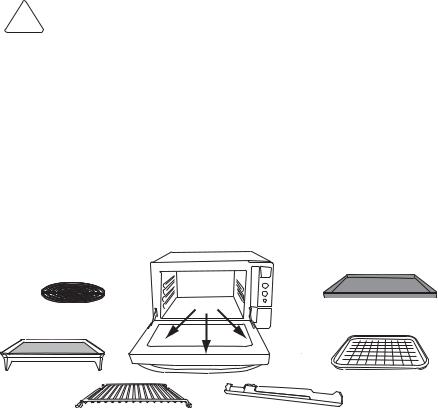
Before using your oven
1.Exterior oven surfaces, including air vents on the cabinet and the oven door will get hot during CONVECTION, GRILLING, COMBINATION involving CONVECTION, GRILL or STEAM functions. To prevent burns, take care when opening or closing the door and when inserting or removing food and accessories.
2.The oven has three grill heaters situated in the top of the oven and a convection heater situated in the back of the oven. During and after using either the CONVECTION, GRILL or COMBINATION involving CONVECTION, GRILL or STEAM functions, all inside surfaces of the oven will be very hot. To prevent burns, care should be taken to avoid touching any of the inside surfaces of the oven or hot water in the steam trough.
3.The accessible parts may become hot when the grill is in use.
4.Do not use the water tank if it is cracked or broken, as leaking water could result in electrical failure and danger of electric shock. If the water tank becomes damaged, please contact your dealer.
5.In case of electronic failure, the oven can only be turned off at the wall socket.
6.Only allow children to use the oven without supervision when adequate instructions have been given so that the child is able to use the oven in a safe way and understands the hazards of improper use, including escaping steam. To prevent burns, ensure that children do not touch either the hot inner surfaces or the hot outer casing after operation of the oven.
7.This appliance is not attended for use by persons (including children) with reduced physical, sensory or mental capabilities, or lack of experience and knowledge unless they have been given supervision or instruction concerning use of the appliance by a person responsible for their safety. Young children should be supervised to ensure that they do not play with the appliance.
!WARNING: This appliance produces hot steam.
8.Storage of Accessories
Do not store any objects other than oven accessories inside the oven in case it is accidentally turned on. In case of electronic failure, oven can only be turned off at wall socket.
9.Before Use
Before using CONVECTION, COMBINATION or GRILL function for the first time operate the oven without food and accessories on CONVECTION 250°C for 5 mins. This will allow the oil that is used for rust protection to be burned off. This is the only time that the oven is operated empty (except preheating on CONVECTION or COMBINATION modes which does not include Microwave).
CAUTION: All inside surfaces of the oven will be hot.
NEVER OPERATE THE OVEN WITHOUT FOOD INSIDE ON MICROWAVE OR COMBINATION MODE INVOLVING MICROWAVE.
Operation when empty will damage the appliance.
4
Care & Cleaning of your Microwave Oven - IMPORTANT
It is essential for the safe operation of the oven that it is kept clean, and wiped out after each use. Failure to maintain the oven in a clean condition could lead to deterioration of a surface that could adversely affect the life of the appliance and possibly result in a hazardous situation.
1.Switch the oven off before cleaning and unplug at socket if possible.
2.Keep the inside of the oven, door seals and door seal areas clean. When food splatters or spilled liquids adhere to oven walls, door seals and door seal areas wipe off with a damp cloth. Mild detergent may be used if they get very dirty. The use of harsh detergent or abrasives is not recommended.
3.The back of the oven has a self-clean catalytic lining. It is therefore not necessary to clean this area.
4.After using CONVECTION, GRILL or COMBINATION cooking the walls of the oven should be cleaned with a soft cloth squeezed in soapy water. Particular care should be taken to keep the window area clean particularly after cooking by CONVECTION, GRILL or COMBINATION. Stubborn spots inside the oven can be removed by using a small amount of branded conventional oven-cleaner sprayed onto a soft damp cloth. Wipe onto problem spots, leave for recommended time and then wipe off. DO NOT SPRAY DIRECTLY INSIDE THE OVEN.
5.After cooking involving steam function, check and wipe away any excess water which may have condensed within the oven cavity. Empty drip tray (refer to page 31).
6.The outside oven surface should be cleaned with a damp cloth. To prevent damage to the operating parts inside the oven, water should not be allowed to seep into the ventilation openings.
7.If the Control Panel becomes dirty, clean with a soft, dry cloth. Do not use harsh detergents or abrasives on Control Panel. When cleaning the Control Panel, leave the oven door open to prevent the oven from accidentally turning on. After cleaning touch STOP/CANCEL Pad to clear display window.
8.If steam accumulates inside or around the outside of the oven door, wipe with a soft cloth. This may occur when the microwave oven is operated under high humidity conditions and in no way indicates a malfunction of the unit or microwave leakage.
9.The oven cavity floor should be cleaned regularly. Simply wipe the bottom surface of the oven with mild detergent and hot water then dry with a clean cloth. Cooking vapours collect during repeated use but in no way affect the bottom surface.
10.For the oven cleaning assistant and system cleaning programs, refer to page 59.
11. When GRILLING or cooking by COMBINATION or CONVECTION some foods may splatter grease onto the oven walls. If the oven is not cleaned to eliminate this grease, it can accumulate and cause the oven to ‘SMOKE’ during use. These marks will be more difficult to clean later. There is no need to clean the catalytic lining at the back of the oven.
12.Ensure all accessories are kept scrupulously clean, especially when using microwave or combination programs.
13.A steam cleaner is not to be used for cleaning.
14.Do not use harsh abrasive cleaners or sharp metal scrapers to clean the oven door glass since they can scratch the surface, which may result in shattering of the glass.
5

Maintenance of your oven
1.Service
WHEN YOUR OVEN REQUIRES A SERVICE call your local
Panasonic engineer (Customer Care Centre on 08705 357357 can recommend an engineer). It is hazardous for anyone other than a competent person to carry out any service or repair operation which involves the removal of a cover which gives protection against exposure to microwave energy.
2.Door Seals
Do not attempt to tamper with or make any adjustments or repairs to door, control panel housing, safety interlock switches or any other part of the oven. Do not remove outer panel from oven.
The door seals and door seal areas should always be kept clean – use a damp cloth.
N.B. The appliance should be inspected for damage to the door seals and door seal areas. If these areas are damaged the appliance should not be operated until it has been repaired by a service technician trained by the manufacturer.
3.Water tank
Do not use the water tank if it is cracked or broken, as leaking water could result in electrical failure and danger of electric shock. If the water tank becomes damaged, please contact your dealer.
4.Oven Light
The oven lamp must be replaced by a service technician trained by the dealer. DO NOT attempt to remove the outer casing from the oven.
5.Selected Spares and Accessories
These may be ordered direct; on line at www.panasonic.co.uk or by telephoning the Customer Care Centre 08705 357357. Most major credit and debit cards are accepted. Ensure you quote the correct model number.
6.Operating the circuit breaker
If the oven is not operating correctly, please check the position of the breaker switch. If the switch is at the ‘O’ position, please position it to the ‘I’ position. If the switch does not return to the ‘I’ position, please contact
your dealer.
7. Testing the circuit breaker
To ensure that the breaker is in working order, please test it regularly by pressing the ‘TEST’ key. Testing it once a month is recommended.
Press the ‘TEST’ key when the oven is switched on. If the switch does not go back to ‘O’, please contact your dealer.
6
Parts of Your Oven
1.Do not cook directly on oven cavity floor. Always place food in a microwave safe dish.
2.The metal accessories provided must ONLY be used as directed for GRILLING, CONVECTION and COMBINATION cooking. Never use metal accessories when cooking in microwave only mode. Do not use if operating the oven with less than 200 g (7 oz) of food on a manual Combination program. Use the Enamel Shelf on CONVECTION and GRILL mode only. The maximum weight that can be used on the enamel shelf is 4 kg (8 lb 14 oz). FAILURE TO USE ACCESSORIES CORRECTLY COULD DAMAGE YOUR OVEN.
3.Arcing may occur if the incorrect weight of food is used, a metal container has been used incorrectly, or the accessories have been damaged. If this occurs, stop the machine immediately. You can continue to cook by GRILL OR CONVECTION ONLY.
4.Always refer to instructions for correct accessories to use on all programs.
Pyrex® Dish
1.The Pyrex® dish can be used directly on the ceramic plate to cook in MICROWAVE mode only. Do not place food directly on the ceramic plate on the oven cavity floor.
2.The Pyrex® dish is used together with the plastic trivet for STEAM mode.
3.The Pyrex® dish can be used directly on the wire shelf (in either of the shelf positions) for cooking in GRILL, CONVECTION or COMBINATION modes.
4.If the Pyrex® dish is hot, let it cool before cleaning or placing in cold water, as this could crack or shatter the dish.
Plastic Trivet
1.The plastic trivet is placed inside the Pyrex® dish to cook on STEAM mode. Food can be placed directly on the plastic trivet.
2.The plastic trivet can be used for defrosting bread.
3.Do not use the plastic trivet for GRILL, CONVECTION or COMBINATION modes.
Anti Spark Ring
1.Place the anti spark ring on top of the wire shelf, then place any metal container. Your metal containers can then be used in COMBINATION mode without arcing.
2.The anti-spark ring should not be used in CONVECTION or COMBINATION modes above 250˚C.
Wire Shelf
1.The wire shelf can be used in the upper shelf position for GRILLING foods. It can be used in the upper or lower shelf positions for CONVECTION or COMBINATION cooking.
2.Do not use any metal container directly on the Wire Shelf in COMBINATION with MICROWAVE. (Refer to paragraph about anti-spark ring).
3.Do not use the Wire Shelf in MICROWAVE mode only.
Enamel Shelf
1.The Enamel Shelf is for cooking on CONVECTION or GRILL mode. Do not use on
MICROWAVE or COMBINATION modes.
2.For 2 level CONVECTION cooking, the Enamel Shelf can be used as the lower level and the wire shelf can be used as the upper level.
Drip Tray
1.Before using the oven, place the drip tray in position. Holding with both hands, click into position on the oven legs. To remove the drip tray refer to page 31.
2.The purpose of the drip tray is to collect excess water during STEAM mode. It should be emptied after each STEAM operation.
7
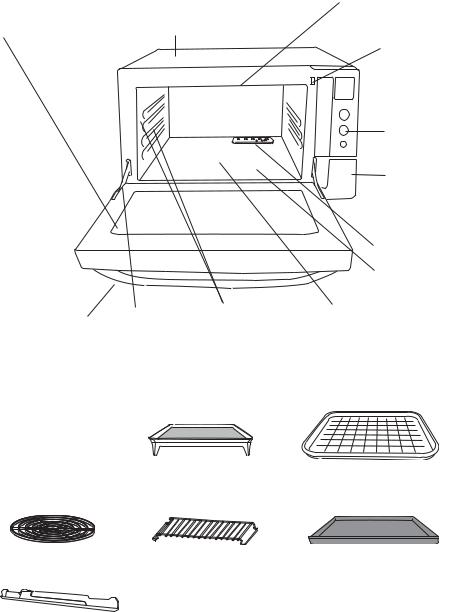
Parts of Your Oven
Grill Elements
See-through Oven Window |
External Air Vents |
Pull Down Door
Pull the door handle downwards to open. Opening the door during cooking will stop the cooking process without cancelling the program. Cooking resumes as soon as the door is closed and Start pad is pressed. The oven light will turn on and stay on whenever the door is opened.
Anti-spark ring
Drip tray
Door Hinge. |
Shelf positions |
Ensure care is taken when closing the door to prevent injury caused by trapping fingers.
Door safety lock system. To prevent injury, do not insert finger, knife, spoon or other object into the latch hole.
Control Panel
Water tank
Ceramic cover
Ceramic plate
Bottom microwave feeding
Plastic Trivet for Pyrex® Dish. Used for steam cooking only
Wire Shelf
Use on CONVECTION, GRILL or TURBO BAKE (Convection & Grill) and COMBINATION modes only. Do not use in MICROWAVE only mode.
Pyrex® Dish
Enamel shelf
Use on CONVECTION, GRILL or TURBO BAKE (Convection & Grill) mode only. Do not use in MICROWAVE only or COMBINATION cooking modes.
8
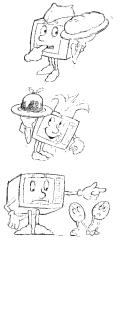
Important Information – Read Carefully
Safety
If smoke or a fire occurs in the oven, press Stop/Cancel pad and leave the door closed in order to stifle any flames.
Disconnect the power cord, or shut off power at the fuse or the circuit breaker panel.
Short Cooking Times
As microwave cooking times are much shorter than other cooking methods it is essential that recommended cooking times are not exceeded without first checking the food.
Cooking times given in the cook book are approximate. Factors that may affect cooking times are: preferred degree of cooking, starting temperature, altitude, volume, size and shape of foods and utensils used. As you become familiar with the oven, you will be able to adjust these factors.
It is better to undercook rather than overcook foods. If food is undercooked, it can always be returned to the oven for further cooking. If food is overcooked, nothing can be done. Always start with minimum cooking times.
Important.
If the recommended cooking times are exceeded the food will be spoiled and in extreme circumstances could catch fire and possibly damage the interior of the
oven.
1.Small Quantities of Food.
Take care when heating small quantities of food as these can easily burn, dry out or catch fire if cooked too long. Always set short cooking times and check the food frequently.
NEVER OPERATE THE OVEN WITHOUT FOOD INSIDE ON MICROWAVE OR COMBINATION MODE INVOLVING MICROWAVE.
2.Foods Low in Moisture.
Take care when heating foods low in moisture, e.g. bread items, chocolate, popcorn, biscuits and pastries. These can easily burn, dry out or catch on fire if cooked too long.
3.Christmas Pudding.
Christmas puddings and other foods high in fats or sugar, e.g. jam, mince pies, must not be over heated. These foods must never be left unattended as with over cooking these foods can ignite.
4.Eggs.
Eggs in their shell and whole hard-boiled eggs should not be heated in microwave ovens since they may explode even after microwave heating has ended.
5.Foods with Skins.
Potatoes, apples, egg yolk, whole vegetables and sausages are examples of food with non porous skins. These must be pierced using a fork before cooking to prevent bursting.
9

6.Liquids.
Liquids and other foods must not be heated in sealed containers since they are liable to explode. When heating liquids, eg soup, sauces and beverages in your microwave oven, overheating the liquid beyond boiling point can occur without evidence of bubbling.
This could result in a sudden boil over of the hot liquid. To prevent this possibility the following steps should be taken:
a)Avoid using straight-sided containers with narrow necks.
b)Do not overheat.
c)Stir the liquid before placing the container in the oven and again halfway through the heating time.
d)After heating, allow to stand in the oven for a short time, stirring again before carefully removing the container.
e)Microwave heating of beverages can result in delayed eruptive boiling, therefore care should be taken when handling the container.
7.Lids.
Always remove the lids of jars and containers and takeaway food containers before you microwave them. If you don’t then steam and pressure might build up inside and cause an explosion even after the microwave cooking has stopped.
8.Deep Fat Frying.
Do not attempt to deep fat fry in your oven.
9.Meat Thermometer.
Use a meat thermometer to check the degree of cooking of roasts and poultry only when meat has been removed from the microwave. If undercooked, return to the oven and cook for a few more minutes at the recommended power level. Do not leave a conventional meat thermometer in the oven when microwaving.
10.Paper, Plastic.
When heating food in plastic or paper containers, keep an eye on the oven due to the possibility of ignition. Do not use wire twist-ties with roasting bags as arcing will occur.
Do not use re-cycled paper products, e.g. Kitchen roll unless they say they are specifically designed for use in a microwave oven. These products contain impurities which may cause sparks and/or fires when used.
11.Reheating.
It is essential that reheated food is served “piping hot”.
Remove the food from the oven and check that it is “piping hot”, i.e. steam is being emitted from all parts and any sauce is bubbling. (If you wish you may choose to check the food has reached 72˚C with a food thermometer – but remember do not use this thermometer inside the microwave.)
For foods that cannot be stirred, e.g. lasagne, shepherds pie, the centre should be cut with a knife to test it is well heated through.
Even if a manufacturer’s packet instructions have been followed always check the food is piping hot before serving and if in doubt return your food to the oven for further heating.
10

Important Information – Read Carefully
12.Standing Time.
Standing time refers to the period at the end of cooking or reheating when food is left before being eaten, i.e. it is a rest time which allows the heat in the food to continue to conduct to the centre, thus eliminating cold spots.
13.Keeping Your Oven Clean.
It is essential for the safe operation of the oven that it is wiped out regularly. Use warm soapy water, squeeze the cloth out well and use to remove any grease or food from the interior. Pay particular attention to the door seal area. The oven should be unplugged when cleaning. The catalytic lining at the back does not need to be cleaned.
14.Grilling.
The oven will only operate on the GRILL function with the door closed.
15.Fan Motor Operation.
After using the microwave oven, the fan motor may operate to cool the electric components. This is normal and you can take out food even though the fan motor operates. You can continue using the oven during this time.
16.Containers.
Before use, check that utensils/containers are suitable for use in microwave ovens.
17.Babies Bottles and Food Jars.
When reheating babies bottles always remove top and teat. Liquid at the top of the bottle will be much hotter than that at the bottom and must be shaken thoroughly before checking the temperature. The lid must also be removed from babies food jars, the contents must also be stirred or shaken before the temperature is checked. This should be carried out before consumption in order to avoid burns.
18.Arcing
Arcing may occur if a metal container has been used incorrectly, if the incorrect weight of food is used, or if the accessories have been damaged. Arcing is when blue flashes of light are seen in the microwave oven. If this occurs, stop the machine immediately. If the oven is left unattended and this continues it can damage the machine.
You can continue to cook by GRILL OR CONVECTION ONLY.
19.Maximum weight on turntable/enamel shelf
The maximum weight that can be placed on the wire shelf or enamel shelf is 4 kg (8 lb 14 oz) (this includes total weight of food and dish).
11
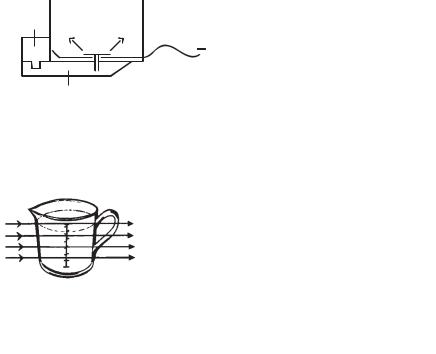
Microwaving Principles
Microwave energy has been used in this country to cook and reheat food since early experiments with RADAR in World War II. Microwaves are present in the atmosphere all the time, both naturally and from manmade sources.
Manmade sources include radar, radio, television, telecommunication links and mobile phones.
HOW MICROWAVES COOK FOOD
Magnetron |
|
|
Oven cavity |
|
|||
|
|
|
|
In a microwave oven, electricity is converted
 into microwaves by the MAGNETRON.
into microwaves by the MAGNETRON.
Waveguide
REFLECTION
The microwaves bounce off the metal walls and the metal door screen.
TRANSMISSION
Then they pass through the cooking containers to be absorbed by the water molecules in the food, all foods contain water to a more or lesser extent.
Microwave |
Water Molecule Absorption |
Vibration |
The microwaves cause the water molecules to vibrate which causes FRICTION, i.e. HEAT. This heat then cooks the food. Microwaves are also attracted to fat and sugar particles, and foods high in these will cook more quickly. Microwaves can only penetrate to a depth of 11⁄2-2 inches (4-5 cm) and as heat spreads through the food by conduction, just as in a traditional oven, the food cooks from the outside inwards.
12

Important Notes
The dish used to cook or reheat the food will get warm during cooking, as the heat conducts from the food. Even in microwaving, oven gloves are required!
MICROWAVES CANNOT PASS THROUGH METAL AND THEREFORE METAL COOKING UTENSILS CAN NEVER BE USED IN A MICROWAVE, FOR COOKING ON MICROWAVE ONLY
Foods Not Suitable for Cooking by Microwave Only:
Yorkshire Puddings, Souffles, Double Crust Pastry Pies.
Because these foods rely on dry external heat to cook correctly, do not attempt to cook by microwave.
Foods that require deep fat frying cannot be cooked either.
Boiled Eggs
Do not boil eggs in your microwave. Raw eggs boiled in their shells can explode and cause serious injury.
STANDING TIME
When a microwave oven is switched off, the food will continue to cook by conduction – NOT BY MICROWAVE ENERGY. Hence STANDING TIME is very important in microwaving, particularly for dense foods i.e. meat, cakes and reheated meals (refer to page 14).
13
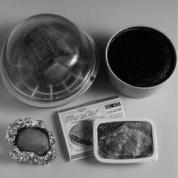
General Guidelines
STANDING TIME
Dense foods e.g. meat, jacket potatoes and cakes, require a STANDING TIME (inside or outside of the oven) after cooking, to allow heat to finish conducting through the food.
MEAT JOINTS – Stand 15 mins. wrapped in aluminium foil.
JACKET POTATOES – Stand 5 mins. wrapped in aluminium foil when cooked by microwave only. It is not necessary to stand jacket potatoes cooked in COMBINATION mode.
LIGHT CAKES – Stand 5 mins. before removing from dish.
RICH DENSE CAKES – Stand 15-20 mins.
FISH – Stand 2-3 mins.
EGG DISHES – Stand 1-2 mins.
PRECOOKED CONVENIENCE FOODS – Stand for 2-3 mins.
PLATED MEALS – Stand for 2-3 mins.
VEGETABLES – Boiled potatoes benefit from standing
1-2 mins., however most other types of vegetables can be served immediately.
DEFROSTING – It is essential to allow standing time to
complete the process. This can vary from 5 mins. e.g. raspberries, to up to 1 hour for a joint of meat.
If food is not cooked after STANDING TIME, return to oven and cook for additional time.
14
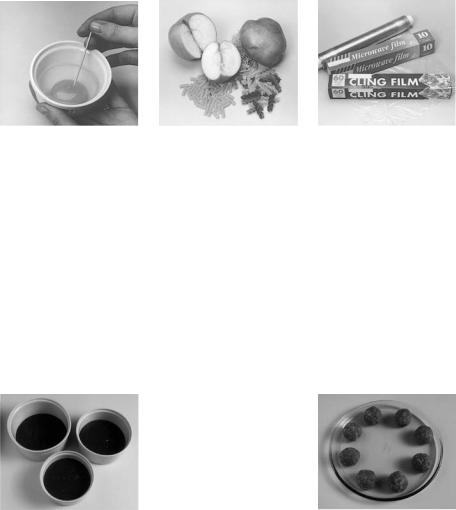
General Guidelines
PIERCING
The skin or membrane on some foods will cause steam to build up during cooking. These foods must be pierced or a strip of skin should be peeled off before cooking to allow the steam to escape. Eggs, potatoes, apples, sausages etc., will all need to be pierced before cooking. DO NOT ATTEMPT TO BOIL EGGS IN THEIR SHELLS.
MOISTURE CONTENT
Many fresh foods e.g. vegetables and fruit, vary in their moisture content throughout the season. Jacket potatoes are a particular example of this. For this reason cooking times may have to be adjusted throughout the year. Dry ingredients e.g. rice, pasta, can dry out further during storage and cooking times may differ from ingredients freshly purchased.
CLING FILM
Cling film helps keep the food moist and the trapped steam assists in speeding up cooking times. However, it should be pierced before cooking, to allow excess steam to escape. Always take care when removing cling film from a dish as the build-up of steam will be very hot. Always purchase cling film that states on the packet “suitable for microwave cooking” and use as a covering only. Do not line dishes with cling film. Do not cover foods when cooking by COMBINATION, CONVECTION or GRILL.
DISH SIZE
Follow the dish sizes given in the recipes, as these affect the cooking and reheating times. A quantity of food spread in a bigger dish cooks and reheats more quickly.
QUANTITY
Small quantities cook faster than large quantities, also small meals will reheat more quickly than large portions.
SPACING
Foods cook more quickly and evenly if spaced apart.
NEVER pile foods on top of each other.
15
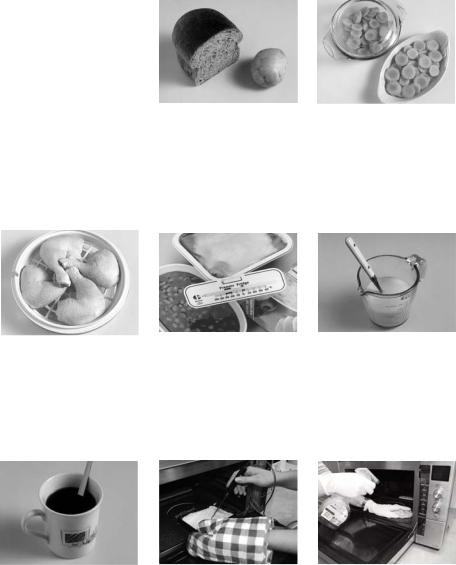
General Guidelines
SHAPE
Even shapes cook evenly. Food cooks better by microwave when in a round container rather than square.
ARRANGING
Individual foods e.g. chicken portions or chops, should be placed on a dish so that the thicker parts are to the outside.
LIQUIDS
All liquids must be stirred before and during heating. Water especially must be stirred before and during heating, to avoid eruption.
Do not heat liquids that have previously been boiled. DO NOT OVERHEAT. Stir before serving
DENSITY
Porous airy foods heat more quickly than dense heavy foods.
STARTING
TEMPERATURE
The colder the food, the longer it takes to heat up. Food from a fridge takes longer to reheat than food at room temperature. Food temperature should be between 5-8°C before cooking.
CHECKING FOOD
It is essential that food is checked during and after a recommended cooking time, even if an AUTO PROGRAM has been used (just as you would check food cooked in a conventional oven). Return the food to the oven for further cooking if necessary.
16
COVERING
Cover foods with microwave cling film or a self-fitting lid.
Cover fish, vegetables, casseroles, soups. Do not cover sauces, jacket potatoes, pastry items. Please refer to cooking charts and recipes for more information.
TURNING AND
STIRRING
Some foods require stirring during cooking. Meat and poultry should be turned after half the cooking time.
CLEANING
As microwaves work on food particles, keep your oven clean at all times. Stubborn spots of food can be removed by using a branded oven cleaner, sprayed onto a soft cloth, always wipe the oven dry after cleaning. Avoid cleaning any plastic parts and door area. The catalytic lining at the back is self cleaning.
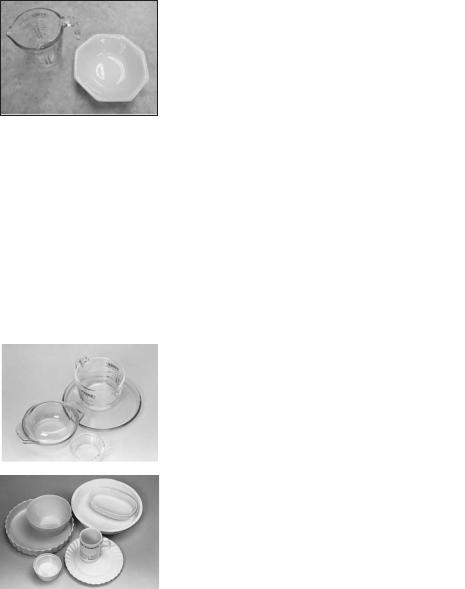
Containers to use
Choosing the correct container is a very important factor in deciding the success or failure of your cooking.
Testing Dishes for Suitability - For Microwave Cooking Only.
When unsure that a cooking container is suitable for use in your microwave, check by the following test:
1.Fill a microwave safe measuring jug with 300ml (1⁄2 pt) cold water.
2.Place it on the base of the oven alongside the dish to be tested. If the dish you are testing is a large dish, then stand the measuring jug on top of the empty dish.
3.Heat on HIGH power for 1 minute.
Result
If the dish is suitable for microwaving, it will remain cool, whilst the water in the jug will begin to feel warm. If the testing dish feels warm, do not use as it is obviously absorbing microwave energy.
N.B. This test does not apply to plastic or metal based containers e.g. Le Creuset® style dishes, which should not be used as they are cast iron covered with enamel.
QUICK CHECK GUIDE TO COOKING UTENSILS
OVEN GLASS
Everyday glass that is heat resistant e.g. Pyrex®, is ideal for Microwave, Convection, Grill or Combination cooking. Do not use delicate glass or lead crystal which may crack or arc.
CHINA AND CERAMIC
Everyday glazed china, porcelain or ceramic plates, bowls, mugs and cups can be used if they are heat resistant. Fine bone china should only be used for reheating for short periods. Do not use dishes with a metal rim or pattern. Do not use jugs or mugs with glued handles, since the glue can melt. If dishes are heat resistant they may be used on Convection and Combination but not directly under the Grill.
17

Containers to use
POTTERY, EARTHENWARE, STONEWARE
If completely glazed, these dishes are suitable. Do not use if partially glazed or unglazed, since they are able to absorb water which in turn absorbs microwave energy, making the container very hot and slows down the cooking of food.
FOIL/METAL CONTAINERS
NEVER ATTEMPT TO COOK IN FOIL OR METAL containers on Microwave only as the microwaves cannot pass through and the food will not heat evenly, it may also damage your oven. Foil and metal containers can be used on Grill and Convection modes and may be used with care during certain Combination cooking, as long as they are not damaged or dented.
CLING FILM
Microwave cling film can only be used for covering food that is reheated by Microwave or Steam. It is also useful for covering food to be cooked, but care should be taken to avoid the film being in direct contact with the food. DO NOT USE ON ANY OTHER COOKING MODE.
ROASTING BAGS
Roasting bags are useful when slit up one side to tent a joint, for roasting by power and time. Do not use the metal twists supplied, when using Microwave or Combination.
ALUMINIUM FOIL
Small amounts of smooth aluminium foil can be used to SHIELD joints of meat during defrosting and cooking by Microwave, as the microwaves cannot pass through the foil, this prevents the parts shielded from overcooking or overdefrosting. Take care that the foil does not touch the sides or roof of the oven, as this may cause arcing and damage your oven. Aluminium foil can be used for Convection cooking.
18

Containers to use
PLASTIC
Many plastic containers are designed for microwave use, but do not use for cooking foods high in sugar or fat or for foods that require long cooking times e.g. brown rice.
Only use Tupperware® containers if they are designed for microwave use. Do not use Melamine. Never cook in margarine cartons or yoghurt pots, as these will melt with the heat from the food. If heatproof they can be used for Convection or Combination cooking. DO NOT USE UNDER THE GRILL.
PAPER
Plain white absorbent kitchen paper (kitchen towel) can only be used for microwave cooking e.g. covering blind pastry cases and for covering bacon to prevent splattering. ONLY USE FOR SHORT COOKING TIMES. NEVER RE-USE A PIECE OF KITCHEN TOWEL. ALWAYS USE A FRESH PIECE OF PAPER FOR EACH DISH.
Avoid kitchen paper containing manmade fibres. If you are using branded re-cycled kitchen towel,
check first that it is recommended for microwave use. Do not use waxed or plastic coated cups or plates as the finish may melt. Greaseproof paper can be used to line the base of dishes and to cover fatty foods e.g. bacon rashers, to stop splattering. White paper plates can be used for SHORT REHEATING TIMES, on Microwave only.
WICKER, WOOD AND STRAW BASKETS
Dishes will crack and could ignite.
Do not use wooden dishes in your microwave.
DO NOT USE ON ANY COOKING MODE.
19
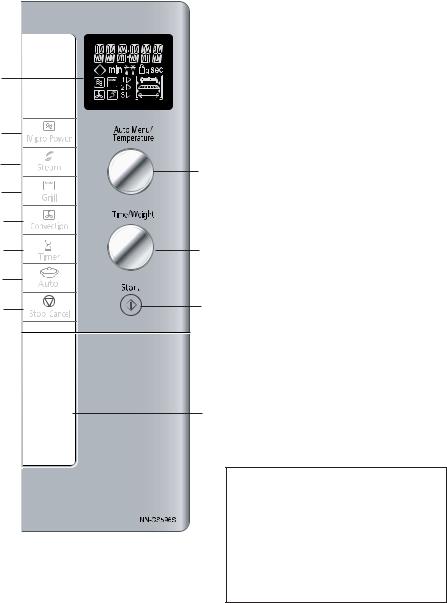
Control Panel
|
|
(1) |
Display Window |
|
|
(2) |
Microwave Power Pad |
|
|
(3) |
Steam Power Pad |
|
|
(4) |
Grill Pad |
(1) |
|
(5) |
Convection Pad |
|
(6) |
Timer Pad |
|
|
|
||
|
|
|
This can be used to delay a cooking |
|
|
|
program for up to 9 hrs 99 mins., or |
(2) |
|
|
used as a timer or for standing |
|
|
(non-cooking) time. Also used for |
|
|
|
|
setting the clock. |
(3) |
(8) |
(7) |
Auto Weight Programs |
|
(8) |
Auto Menu/ Temperature/ |
|
|
|
||
(4) |
|
|
Microwave/Steam wattage/ Grill |
|
|
|
level/ Selector dial |
(5) |
|
(9) |
Time/Weight dial |
|
|
Stop/Cancel |
|
|
|
(10) |
|
(6) |
(9) |
|
Before Cooking: |
|
|
|
one press clears your instructions. |
(7) |
|
|
During Cooking: |
|
|
one press temporarily stops the |
|
|
|
|
|
(10) |
(11) |
|
cooking program. Another press |
|
cancels all your instructions and the |
||
|
|
|
|
|
|
|
time of day will appear in the display. |
|
|
(11) |
Start Pad: |
|
|
|
Press to start operating the oven. |
|
|
|
If during cooking the door is opened or |
|
|
|
Stop/Cancel Pad is pressed once, |
|
|
|
Start Pad has to be pressed again to |
|
(12) |
|
continue cooking. |
|
(12) |
Water tank for steam function |
|
|
|
Beep Sound: |
|
|
|
A beep sounds when a pad is pressed. If this |
|
|
|
beep does not sound, the setting is incorrect. |
|
|
|
When the oven changes from one function to |
|
|
|
another, two beeps sound. After completion of |
|
|
|
preheating on CONVECTION or |
|
|
|
COMBINATION, three beeps sound and ‘P’ |
|
|
|
flashes in the display window. After completion |
|
|
|
of cooking, five beeps sound. |
|
20
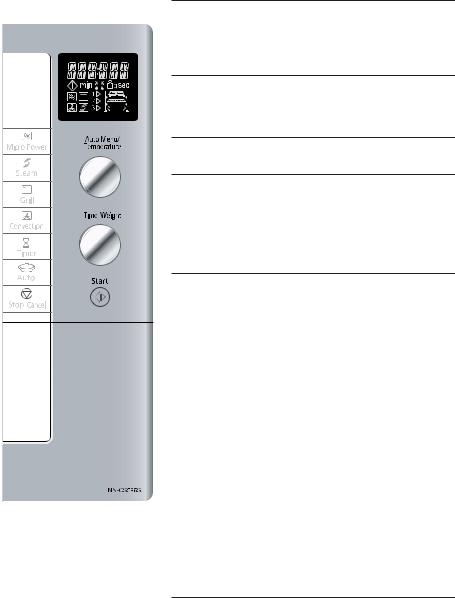
Let’s Start to Use your Oven
1 Plug in
Plug into a 13 amp fused electrical socket. You will be reminded to read your operating instructions.
2 Press Timer Pad
Set clock as a 12hr clock. (See page 22 for details).
3 Press Convection Pad
( will appear in the display window with the oven temperature)
will appear in the display window with the oven temperature)
(This procedure is to burn off the oil used for rust protection in the oven.) Turn the Auto menu Tempeature dial until 250C appears in the display window. Remove all accessories from the oven.
4 Enter Time
Turn Time/Weight dial until 5 minutes is displayed in the window.
5Press Start Pad
The time will be displayed in the window and count down. The oven will beep at the end of the program. The oven is now ready to use.
Caution: Grill elements and oven will be hot.
6 Demonstration Mode
This is to enable you to experiment setting various programs. (The letter D will always appear in the display window. This is to confirm that there is no microwave power produced and it is safe to use the oven without any food). To select this mode press the Timer pad three times.
“Demo mode press any key” will appear. To cancel press the Timer pad a further three times.
7 Child Lock
To operate the child lock facility press the Start pad three times, this will deactivate the microwave. “Lock” will appear in the display and none of the controls will operate. To clear child lock facility press Stop/Cancel three times.
21

Setting the Clock
Press Timer Pad twice
“SET TIME” will appear in the display window, and the colon starts to blink.
N.B.
Enter Time
Enter time of day by using Time/Weight dial e.g. 1.25pm (12hr clock).
Press Timer Pad
Colon stops blinking. Time of day is now locked into the display.
1.To reset time of day, repeat step 1 through to step 3.
2.The clock will keep the time of day as long as the oven is plugged in and electricity is supplied.
3.THIS IS A 12 HOUR CLOCK.
Microwave Cooking and Defrosting
There are 6 different microwave power levels available.
Do not place food directly on the ceramic plate. Place on the Pyrex® dish supplied with the oven or use your own dishes, plates or bowls directly on the ceramic plate.
Selecting Microwave Power Level
|
|
|
|
|
|
|
|
Power |
Wattage |
|
|
|
|
|
|
|
|
|
|
|
|
|
|
|
|
|
|
|
|
|
Level |
|
|
|
|
|
|
|
|
|
|
|
|
|
|
|
|
|
|
|
|
|
|
|
|
|
|
|
|
|
|
|
|
|
||||
|
|
|
|
|
|
|
|
High |
1000W |
|
|
|
|
|
|
|
|
|
|
|
|
|
|
|
|
|
|
|
|
|
Defrost |
270W |
|
|
|
|
|
|
|
|
|
|
|
|
|
|
|
|
|
|
|
|
|
|
|
|
|
|
|
|
|
|
|
|||||
|
|
|
|
|
|
|
|
Medium |
600W |
|
|
|
|
|
|
|
|
|
|
|
|
|
|
|
|
|
|
|
|
|
|
|
|
|
|
|
|
|
|
|
|
|
|||
|
|
|
|
|
|
|
|
Low |
440W |
|
|
|
|
|
|
|
|
|
|
|
|
|
|
|
|
|
|
|
|
|
|
|
|
|
|
|
|
|
|
|
|||||
|
|
|
|
|
|
|
|
Simmer |
250W |
|
|
|
|
|
|
|
|
|
|
|
|
|
|
|
|
|
|
|
|
|
|
|
|
|
|
|
|
|
|
|
|||||
• Select |
• Select Microwave |
Warm |
100W |
|
|
|
|
|||||||||||||||
• Select the |
|
• Press Start |
||||||||||||||||||||
|
Microwave |
power level |
|
|
|
cooking time |
|
|
|
Pad. |
||||||||||||
|
power cooking |
|
|
|
|
|
|
|||||||||||||||
|
by turning the Auto |
|
|
|
using the |
|
|
|
|
|
|
|
|
|||||||||
|
mode. |
|
|
|
|
|
|
|
|
|
|
|
||||||||||
|
Menu/Temperature |
|
|
|
Time/Weight |
|
|
|
|
|
|
|
|
|||||||||
|
|
|
|
|
|
|
|
|
|
|
|
|
|
|
|
|||||||
|
|
|
|
|
Dial. The Microwave |
|
|
|
Dial. |
|
|
|
|
|
|
|
|
|||||
|
|
|
|
|
|
|
|
|
|
|
|
|
|
|
|
|||||||
|
|
|
|
|
power level appears |
|
|
|
|
|
|
|
|
|
|
|
|
|
|
|||
|
|
|
|
|
|
|
|
|
|
|
|
|
|
|
|
|
|
|
|
|
|
|
in the display.
CAUTION: The oven will automatically work on HIGH microwave power if a cooking time is entered without the power level previously being selected.
N.B.
1.Maximum time that can be set on HIGH power is 30 minutes.
2.On all Power Levels, except HIGH power, the maximum time that can be set is 90 minutes.
3.You can add to the cooking time during cooking, if required. Turn Time/ Weight Dial to increase the cooking time. (Time can be added in 1 minute increments up to maximum time of 10 minutes. This is only the case for one stage cooking).
22

Microwave Cooking and Defrosting
DO NOT attempt to use microwave only with any metal accessory in the oven.
DO NOT place food directly onto the oven cavity floor. Place in a microwave or Pyrex® dish.
Foods reheated or cooked by MICROWAVE only are normally covered with a lid or cling film, unless otherwise stated.
Two Stage Cooking:
e.g. High power 10 mins followed by Simmer power 20 mins; Select High power and program 10 mins then select second power (Simmer) with second cooking time (20 mins) then press Start.
Three Stage Cooking:
e.g. High power 5 mins, Delay 5 mins, High power 2 mins; Select first Power level and cooking time, then press TIMER and time, then select final power level and final cooking time. Then press Start.
Auto Weight Defrost - Chaos Defrost
With this feature you can defrost frozen foods according to the weight. Select the category and set the weight of the food. The weight can be programmed in pounds and ounces or grams. The weight starts from the minimum weight for each category.
•Press the Auto Weight Program Pad.
•Turn the Auto Menu/Temperature dial to select the desired program.
•The default weight setting is grams. To select pounds and ounces, press Auto Weight Program.
Press again to revert back to grams.
|
|
|
|
|
|
|
|
• Set the weight |
• Press Start Pad. |
||
of the food by |
The display |
||
using the |
reminds you |
||
Time/Weight |
which accessory |
||
Dial. |
to use and |
||
|
which cooking |
||
|
modes are in |
||
|
use. |
||
|
Program |
Weight Range |
Suitable Foods |
||
1 |
Bread |
100 |
- 900 g (4 oz - 2 lb) |
Bread and rolls. Place on Plastic Trivet in Pyrex® Dish. |
|
Turn at beep. |
|||||
|
|
|
|
||
|
|
|
|
|
|
|
|
200 |
- 1200 g |
Small pieces of meat, minced meat, chicken |
|
2 |
Meat Items |
portions, steaks, chops. Place on a plate or |
|||
(7 oz - 2 lb 10 oz) |
|||||
|
|
shallow dish. Turn at beeps. |
|||
|
|
|
|
||
|
|
|
|
|
|
|
|
400 |
- 2000 g |
Whole chicken, meat joints. Place on a plate on |
|
3 |
Meat Joints |
an upturned saucer. Turn at beeps and |
|||
(14 oz- 5 lb 8 oz) |
|||||
|
|
shield. |
|||
|
|
|
|
||
|
|
|
|
|
|
23
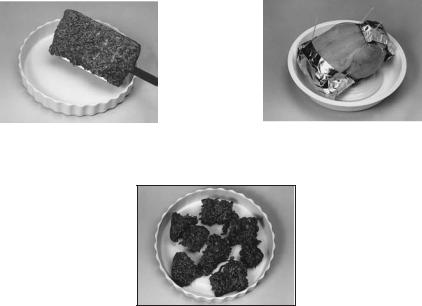
Auto Weight Defrost Programs
This feature allows you to defrost minced meat, chops, chicken portions, meat joints and bread.
The Auto program pad and then the Auto menu/ Temperature Dial should be used to select the correct defrost category and then enter in the weight of the food in grams or pounds and ounces using the appropriate pads (see page 23).
Foods should be placed in a suitable dish, whole chickens and joints of meat should be on an upturned saucer or on a rack. Chops, chicken portions and slices of bread should be placed in a single layer. It is not necessary to cover the foods. The plastic trivet can be used for defrosting bread.
The CHAOS Theory principle is used in Auto Weight defrost programs to give you a quick and more even defrost.
The CHAOS system uses a random sequence of pulsing microwave energy which speeds up the defrosting process.
During the program the oven will beep to remind you to check the food.
IT IS ESSENTIAL THAT YOU TURN AND STIR THE FOOD FREQUENTLY AND SHIELD IF NECESSARY (See page 26).
On hearing the first beep you should TURN and SHIELD (if possible). On the second beep you should turn the food or break it up.
1st Beep |
|
1st Beep |
|
|
|
|
|
|
Turn |
or |
Shield |
2nd Beep
Turn or break up
24

Auto Weight Defrost Programs CHAOS
DEFROST
CATEGORY 1 BREAD
The Bread Program is suitable for defrosting small items e.g. rolls, buns and slices of bread which are required for immediate use. The plastic trivet can be used for defrosting bread. Small items may feel warm immediately after defrosting. Loaves can also be defrosted on this program but these will require standing time to allow the centre to thaw out. Standing time can be shortened if slices are separated and buns and loaves cut in half. Items should be turned halfway during defrosting. THIS PROGRAM IS NOT SUITABLE FOR CREAM CAKES OR DESSERTS e.g. cheesecake.
CATEGORY 2 MEAT ITEMS (MINCE/CHOPS/CHICKEN PORTIONS)
It is necessary for mince to be broken up frequently during defrosting and this is best carried out in a large shallow dish. Chops and chicken portions should be arranged in a single layer and turned frequently.
CATEGORY 3 MEAT JOINTS/WHOLE CHICKENS
Meat joints and chickens will require shielding during defrosting especially if they are particularly fatty pieces. This is to prevent over defrosting on the outside edges. Smooth foil secured with cocktail sticks should be used. DO NOT ALLOW THE FOIL TO TOUCH THE WALLS OF THE OVEN. Back fat of joints, legs, wings and breast bones need shielding (see photograph on next page). Standing time of at least 1 hour should be allowed (rolled joints may require longer) before cooking to ensure the centre is fully defrosted.
Defrosting Guidelines
TIPS
1Check foods during defrosting. Foods vary in their defrosting speed.
2It is not necessary to cover the food.
3Always turn or stir the food especially when
the oven “beeps’’. Shield if necessary (see point 5).
4Minced meat/chops/chicken portions should be broken up or separated as soon as possible and placed in a single layer.
5Shielding prevents food cooking. It is essential when defrosting chickens and joints of meat. The outside thaws out first, so protect wings/breast/fat with smooth pieces of aluminium foil secured with cocktail sticks.
6Allow standing time so
that the centre of the food thaws out (minimum 1 hour for joints of meat and whole chickens).
25
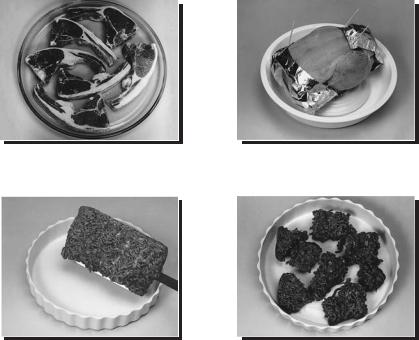
Defrosting Foods Using Defrost Power & Time
By selecting the DEFROST power level from the microwave power pad, and setting a time, you can defrost food in your microwave. The biggest problem is getting the inside defrosted before the outside starts to cook.
For this reason a defrost program alternates between a defrost power and a standing time. The name for this type of defrost is cyclic. During the standing
Separate chops and small items e.g. bread slices where possible.
Turn dense foods and meat 2-3 times during defrosting.
stages there is not any microwave power in the oven, although the light will remain on. The automatic stand times ensure a more even defrost but it is still necessary to allow for standing time before use. Place foods in a suitable container. Meat joints and chickens should be placed on an upturned saucer or on a plastic rack if you have one.
Chickens and joints of meat will require shielding during defrosting.
Break up small items e.g. minced meat, frequently during defrosting.
26

Defrosting Foods Using Defrost Power & Time
The times given below are a guideline only. Always check the progress of the food by opening the oven door and then re-starting. For larger quantities adjust times accordingly. Food should not be covered during defrosting.
|
Food |
Weight |
Defrosting |
Method |
Standing |
||
|
Time |
Time |
|||||
|
|
|
|
|
|||
|
|
|
|
|
|
|
|
|
MEAT |
|
|
|
|
|
|
|
|
|
|
|
|
|
|
|
Beef/Lamb/Pork Joint |
700g |
(1lb 8oz) |
15 mins |
Place in a suitable dish or on an upturned saucer or use a rack. Turn 3 - 4 |
60 mins |
|
|
|
|
|
|
times. |
|
|
|
|
|
|
|
|
||
|
Beef/Lamb/Pork Joint |
1.0 Kg (2lb 4oz) |
20 mins |
Place in a suitable dish or on an upturned saucer or use a rack. Turn 3 - 4 |
60 mins |
||
27 |
|
|
|
|
times. |
|
|
|
|
|
|
|
|
||
Sirloin/Rump Steak |
500g |
(1lb 2oz) |
10 mins |
Place in a suitable dish. Separate and turn twice. |
15 mins |
||
|
|||||||
|
|
|
|
|
|
||
|
|
100 g ( x1) |
3 mins |
Place in a suitable dish. Turn. |
2 mins |
||
|
Beefburgers |
227 g ( x4) |
4-5 mins |
Place in a suitable dish. Separate and turn twice. |
5 mins |
||
|
|
350 g ( x2 ) |
5-6 mins |
Place in a suitable dish. Separate and turn twice. |
10 mins |
||
|
|
|
|
|
|
|
|
|
Minced Beef |
500g |
(1lb 2oz) |
12 mins |
Place in a suitable dish. Break up and turn 3-4 times. |
15 mins |
|
|
|
|
|
|
|
|
|
|
Stewing Steak |
500g |
(1lb 2oz) |
12 mins |
Place in a suitable dish in a single layer. Break up and turn twice. |
20 mins |
|
|
|
|
|
|
|
|
|
|
Lamb Chops |
500g |
(1lb 2oz) |
10 mins |
Place in a suitable dish in a single layer. Turn twice. |
15 mins |
|
|
|
|
|
|
|
|
|
|
Lamb Fillets |
300g |
(11oz) |
3-4 mins |
Place in a suitable dish in a single layer. Turn twice. |
10 mins |
|
|
|
|
|
|
|
|
|
Defrosting Foods Using Defrost Power & Time
The times given below are a guideline only. Always check the progress of the food by opening the oven door and then re-starting. For larger quantities adjust times accordingly. Food should not be covered during defrosting.
|
Food |
Weight |
Defrosting |
Method |
Standing |
|
|
Time |
Time |
||||
|
|
|
|
|
||
|
MEAT |
|
|
|
|
|
|
Lamb Shanks x 4 |
800g |
|
15 mins |
Place in a suitable dish in a single layer. |
45 mins |
|
(1lb12 oz) |
|
Separate and turn twice. Shield if necessary. |
|
||
|
|
|
|
|||
|
|
|
|
|
|
|
|
Pork Ribs |
700g |
(1lb 8oz) |
10 mins |
Place in a suitable dish. Separate and turn twice. |
30 mins |
|
|
|
|
|
|
|
|
Pork Chops |
350g |
(12oz) |
5-6 mins |
Place in a suitable dish. Separate and turn twice. |
15 mins |
|
|
|
|
|
|
|
28 |
Bacon |
250g |
(9oz) |
5-6 mins |
Place in a suitable dish. Separate and turn 2-3 times. |
15 mins |
|
|
|
|
|
|
|
|
Sausages |
100g |
(2) |
11/2 mins |
Place in a suitable dish. Turn. |
5 mins |
|
500g(8) |
5-6mins |
Place in a suitable dish. Turn twice. |
10 mins |
||
|
|
|||||
|
|
|
|
|
|
|
|
Whole Chicken |
1.5 Kg (3lb 5oz) |
30 mins |
Place in a suitable dish or on an upturned saucer or use a rack. Turn 3 - |
60 mins |
|
|
|
|
|
|
4 times. Shield if necessary |
|
|
|
|
|
|
|
|
|
Chicken Portions x 1 |
150g |
(5oz) |
3 mins |
Place in a suitable dish. Turn. |
10 mins |
|
x 2 |
350g |
(12oz) |
6 mins |
Place in a suitable dish. Turn twice. |
15 mins |
|
x 3/4 |
500g |
(1lb 2oz) |
8 mins |
Place in a suitable dish. Turn twice. |
20 mins |
|
|
500-600 g (1 lb |
|
|
|
|
|
|
2 oz1lb 5oz) |
|
|
|
|
|
|
|
|
|
|
|
|
Duck Breast Fillets |
450g |
(1lb) |
9 mins |
Place in a suitable dish. Turn twice. |
20 mins |
|
|
|
|
|
|
|
Defrosting Foods Using Defrost Power & Time
The times given below are a guideline only. Always check the progress of the food by opening the oven door and then re-starting. For larger quantities adjust times accordingly. Food should not be covered during defrosting.
|
Food |
Weight |
Defrosting |
Method |
Standing |
|
|
Time |
Time |
||||
|
|
|
|
|
||
|
|
|
|
|
|
|
|
MEAT |
|
|
|
|
|
|
Whole Fish x 1 |
150-225g |
5-6 mins |
Place in a suitable dish. Turn twice. |
15 mins |
|
|
(5-8oz) |
|||||
|
|
|
|
|
||
|
|
|
|
|
|
|
|
Whole Fish x 2 |
500g |
(1lb 2oz) |
12-14 mins |
Place in a suitable dish. Turn twice separate if necessary. |
20 mins |
|
|
|
|
|
|
|
|
|
100 -150g |
2-3 mins |
|
5 mins |
|
|
Fish Fillets |
(45oz) |
Place in a suitable dish. Separate if necessary and turn twice. |
|||
|
6-7mins |
10 mins |
||||
|
|
350g (12oz) |
|
|||
|
|
|
|
|
||
29 |
|
|
|
|
|
|
|
100g |
(4oz) |
3-4mins |
Place in a suitable dish. Turn. |
10 mins |
|
|
250g |
(9oz) |
6-7 mins |
15 mins |
||
|
Fish Steaks |
Place in a suitable dish. Separate if necessary and turn twice. |
||||
|
|
|
|
|
||
|
|
400g |
(14oz) |
10-12 mins |
Place in a suitable dish. Separate if necessary and turn twice. |
20mins |
|
|
|
||||
|
|
|
|
|
|
|
|
Prawns |
450g |
(1lb) |
10 mins |
Place in a suitable dish. Stir twice during defrosting. |
15 mins |
|
|
|
|
|
|
|
|
GENERAL |
|
|
|
|
|
|
|
|
|
|
|
|
|
Sliced bread |
400g |
(14oz) |
5 mins |
Place on the trivet. Separate and arrange during defrosting. |
10 mins |
|
|
|
|
|
|
|
|
Slice of Bread |
30g (1oz) |
20-30 secs |
Place on the trivet |
1-2 mins |
|
|
|
|
|
|
|
|
|
Soft fruit |
500g |
(1lb 2oz) |
8-9 mins |
Place in a suitable dish. Stir twice during defrosting. |
20 mins |
|
|
|
|
|
|
|
|
Gateau |
350g |
(12oz) |
3-4 mins |
Place on a plate. |
15 mins |
|
|
|
|
|
|
|
|
Cheesecake |
|
|
|
Place on a plate. |
15 mins |
|
|
|
|
|
|
|
|
Meringue dessert |
|
|
|
Place on a plate. |
15 mins |
|
|
|
|
|
|
|
|
Butter |
|
|
|
Place on a plate. |
10 mins |
|
|
|
|
|
|
|
|
Shortcrust /Puff pastry |
500g (1lb 2oz) |
4-5 mins |
Place on a plate. Turn halfway |
15 mins |
|
|
|
|
|
|
|
|
